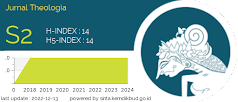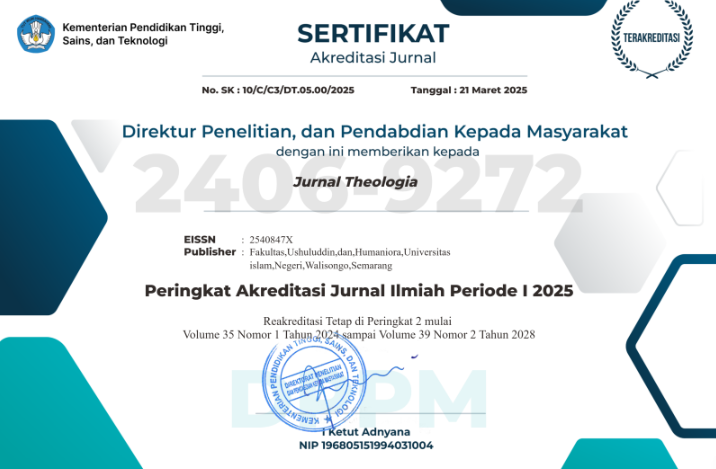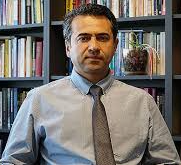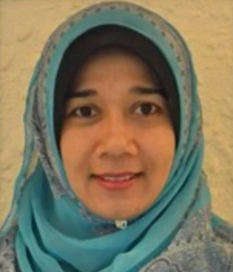Reconstructing the Structure of the Qur'an: Al-Ghazali's Sufistic Approach
DOI:
https://doi.org/10.21580/teo.2023.34.1.17817Keywords:
Structure of al-Qur'an, tartib nuzuli, tartib mushaf, rasm al-usmani,Abstract
This article discusses al-Ghazali's thoughts regarding the structure of the Qur'an which is different from generally known patterns. Al-Ghazali with his Sufistic tendencies rearranged the verses and letters of the Koran into two categories, namely Jawahir and Durar. Jawahir is a verse that is directly related to the nature of Allah, while Durar is a verse that contains instructions to Allah's servants to follow the straight path through righteous deeds that are carried out firmly. Al-Ghazali views the Koran as a means to achieve makrifatullah. The research method used is a literature study with a structuralist approach by examining relevant primary and secondary sources. This article shows that Al-Ghazali's structure of the Qur'an is unique and new, namely linking the verses of the Qur'an to the nature of Allah and the straight path to makrifatullah. This article also contributes to the development of Al-Qur'an studies, especially in the fields of structure and Sufism.Downloads
References
Ahimsa-Putra, Heddy Shri, (2009) “Fenomenologi Agama: Pendekatan Fenomenologi Untuk Memahami Agama”, Walisongo: Jurnal Penelitian Sosial Keagamaan, Vol. 20, Nomor 2, November (2012), DOI: 10.21580/ws.20.2.200
Amal, Taufik Adnan, Rekonstruksi Sejarah al-Qur’an, Yogyakarta: FkBA, 2001.
Ansharuddin, M, Sistematika Susunan Surat di Dalam Al-Qur’an: Telaah Historis, CENDEKIA: Jurnal Studi Keislaman Vol. 2, No 2, Desember 2016. DOI: https://doi.org/10.37348/cendekia.v2i2.26
Arkoun, Mohammad, Berbagai Pembacaan Al-Qur’an, trans. Machasin, Jakarta: INIS, 1997.
Aziz, Farhat, (2013). Structure of the Holy Qur’an, Journal of Islamic Studies and Culture 1 (1), June, 27-59.
Azmi, Asyrifah Luthfiana et. al., Angelica Neuwirth’s Genealogy on Tartib Nuzuli as an Interpretation Method of The Qur’an, Al’adalah, Vol. 25, No.1 (2022): 49-66, https://doi.org/10.35719/aladalah.v25i1.287
al-Baidhowi, Nashiruddin Abi Al-Khair ‘Abdullah, Anwar at-Tanzil wa Asrar at-Ta’wil Beirut: Dar Ihya’ at-Turats al-“Arabi, 1998
Donald, D.B. Mac., First Encyclopaedia of Islam, ed. by. M.Th. Houtsma, et. al., Leiden: E.J. Brill, 1993.
Farrind, Raymond, Structure and Quranic Interpretation: A Studi of Symmetry and Coherence in Islam’s Holy Text. Oregon: White Cloud Press, 2014.
al-Ghazali, Abu Hamid Muhammad bin Muhammad bin Muhammad, al-Mustasfa min 'Ilm al-Usul. Mesir: Dar al-Fikr, 1322 H.
------------, Jawahir al-Qur’an wa Duraruh. Beirut: Dâr al-Fikr, 1997.
------------, al-Munqidz min al-Dhalal . Turki: Dar al-Syafaqah, 1988.
------------, Ihya’ Ulum al-Din. Beirut: Dar al-Kutub al-‘Ilmiyyah, t.th.
Habib, Muslich Shabir, Al-Ghazālī’s Qur’anic Sufi Hermeneutics: Case Study on the Story of Abraham in Search of God, KALAM, Volume 15, No. 02, (2021), 121-144, DOI: http://dx.doi.org/10.24042/klm.v15i2.9523
Hanapi, Abdullah, Antropologi Al-Qur’an dalam Diskursus ‘Ulumul Qur’an Kontemporer, MAGHZA: Jurnal Ilmu Al-Qur’an dan Tafsir, Vol. 8, No. 1 (2023), 145-169. DOI: doi.org/10.24090/maghza.v8i1.7097
Hendricks, Mogamat Mahgadien, The Qur’anic Sufi Hermeneutics of Syakh Mustafā al-Alawī: A Critical Study of Hi s Lubab al-Ilm Fī Surah al-Najm. Bellville: University of the western cape, 2018.
Ibn Khallikan, Abu Abbas Syamsuddin Ahmad bin Muhammad bin Abi Bakr, Wafiyat al-A’yan wa Anba’ Abna’ al-Zaman. Beirut: Dar al-Tsaqafah, t.th.
Majid, Abdul and Arif Sugitanata, Sebuah Kajian Historis: Periodisasi dan Tartib Mushafi Ayat-ayat Al-Qur’an, Al-Bayan: Jurnal Ilmu al-Qur'an dan Hadist, Vol. 4, No. 2. Juni 2021. 213-231 DOI: https://doi.org/10.35132/albayan.v4i2.109
Miswar, Maqamat (Tahapan yang Harus ditempuh dalam Proses Bertasawuf), Jurnal Ansiru PAI, Vol. 1., No. 2, Juli-Des 2017
al-Muhtasib, Abdul Majid, Visi dan Paradigma Tafsir al-Qur’an Kontemporer, trans. M. Maghfur Wachid, Bangil: al-‘Izzah, 1997.
Nasution, Muhammad Yasir, Manusia Menurut al-Ghazali. Jakarta: Raja Grafindo, 1999.
Noldeke, Theodor, Geschichte des Qorans. Leipzig: Dieterichsichte Verlaysbuch Handlung, 1909.
as-Suyuthi, Jalaluddin, al-Itqan fi Ulum al-Qu’an. Beirut: Dar al-Kutub al-Ilmiyyah, 2012.
Solahuddin, Ahmad and Jamaluddin Hadi Kusuma, Keutuhan Surat dalam Struktur al-Quran: Teori Nazm dalam Tafsir Nizam al-Qur’an wa Ta’wil al-Furqan bi al-Furqan Karya Al-Farahi, Ṣuḥuf, Vol. 13, No. 1, Juni 2020, 123-156. DOI: https//doi.org/10.22548/shf.v13i1.510
Syahin, Abdu al-Sabur, Tarikh al-Qur’an. Mesir: Nahdhah Misri, 2007.
Tim Lajnah Pentashih Mushaf Al-Qur’an,”Pedoman Pentashihan Mushaf Al-Qur’an”,. Jakarta: Kementerian Agama Republik Indoneisa, 2019.
Ula, Miftahul, The Al-Muhasibi and Al-Ghazali Sufism Concept (Intertextuality Study of Al-Washaya and Al-Munqidz min Al-Dhalal), Religia: Jurnal Ilmu-Ilmu KeIslaman, Vol. 25 No. 2, DOI:https://doi.org/10.28918/religia.v25i2.6230
Wahyudi, Epistemologi Tafsir Sufi al-Ghazali dan Pergeserannya, Jurnal THEOLOGIA, Vol 29 No 1 (2018), 85-108, DOI: http://dx.doi.org/10.21580/teo.2018.29.1.2070
Watt,, W.M., Bell’s Introduction to The Qur’an. Edinburgh: Edinburgh University Press, 1970.
Whittingham, Martin, Al-Ghazali and The Qur’an: One Books Many Meanings. London: Routledge, 2007.
Yurnalis, Sukri Al Fauzi Harlis and Arrasyid, The Suluk of The Salik in The Concept of Seven Stages (Martabat Tujuh) of Abdel Samad al-Palimbani, Jurnal THEOLOGIA, Vol. 33, No. 1 (2022), 87-99. DOI: http://dx.doi.org/10.21580/teo.2022.33.1.12575
Zaini, Ahmad, Pemikiran Tasawuf Imam Al-Ghazali, Esoterik: Jurnal Akhlak dan Tasawuf, Vol.2, No. 1, 2016, 154. DOI: http://dx.doi.org/10.21043/esoterik.v2i1.1902
az-Zanjani, Abu Abdullah, Wawasan Baru Tarikh al-Qur’an, trans. Kamaluddin Marzuki, Bandung: Mizan Pustaka, 2009.
az-Zarkasyi, Badruddin Muhammad Ibnu Abdullah, Al-Burhan fi Ulumal-Qur’an. t.tp.: Dar al-Ihya al-Kutub al-Arabiyyah, 2000.
az-Zarqâni, Muhammad ‘Abd al-‘Azhîm. Manâhil al-‘Irfân fî ‘Ulûm al-Qur’an. Beirut: Dâr Ihyâ’ at-Turâts al-‘Arabi, t.t.




















